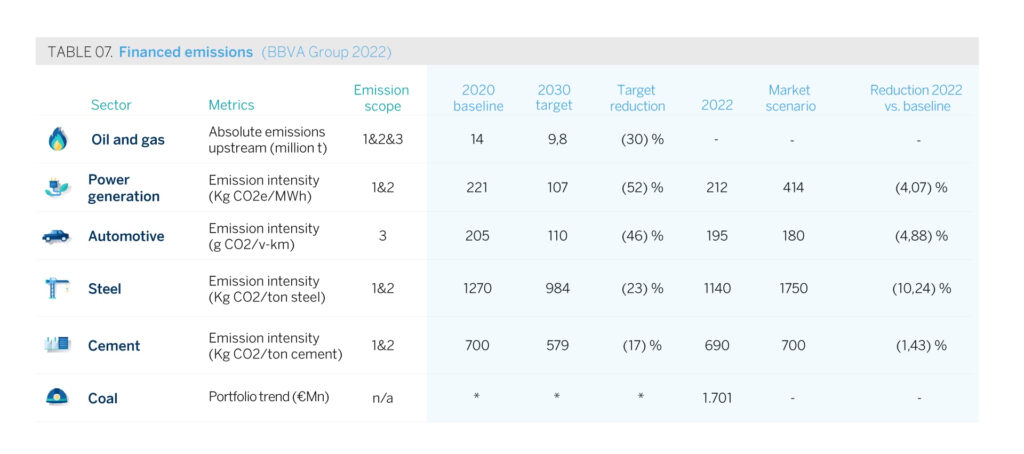|
Getting your Trinity Audio player ready...
|
BBVA has published its clients’ progress toward decarbonization in the initial version of its climate transition plan. The bank is one of the first in the world to apply the recommendations by the Glasgow Financial Alliance for Net Zero (GFANZ) to define a transition plan. Emissions declined in all sectors with published decarbonization indicators. BBVA’s goal is to finance this emission reduction by its clients.
In its fourth report published according to the methodology established by the Task Force on Climate-Related Financial Disclosures (TCFD), BBVA covers its progress in its governance model, strategy, risk management and metrics related to climate change. Some of the latest developments include the creation of the Sustainability Alignment Steering Group, which will monitor clients’ goals and transition plans.
“This is the first TCFD report in which we are incorporating several GFANZ recommendations on putting together a transition plan, a central aspect when it comes to enhancing understanding of how BBVA is tackling the transition through our investors, shareholders, supervisors, regulators, customers, civil society organizations and other interest groups,” the BBVA Chair, Carlos Torres Vila, stated in the letter introducing the report.
Aware that its lending activity and the projects it finances have an indirect impact on the environment and on society, in this document, BBVA reflects on its commitment to align its activity to a scenario of net zero emissions from its clients by 2050. It therefore accompanies its clients with financing, advice and innovative solutions as part of the transition toward a more sustainable future, inspired by the Sustainable Development Goals (SDGs).
Transition plans
The bank is monitoring its clients’ decarbonization strategies and incorporating them into its risk assessment tools. BBVA follows operational indicators that are relevant in the transformation in order to obtain a prospective and individualized overview of each client.
Specifically, for the first time, the TCFD report reflects BBVA’s progress in this commitment, publishing details on the sector plans for which alignment targets have been set: oil and gas; power generation; automotive industry; steel and cement; and phase-out targets, which is the case for the coal sector.
In all cases, progress toward the proposed objectives is not expected to be linear in the short-term, although there have been reductions in all decarbonization indicators.

See related article: BBVA Donates 300,000 to Four NGOs for Projects Related to a Greener and More Inclusive World
According to the recommendations of the Net Zero Banking Alliance (NZBA), in the oil and gas sector, progress should be communicated 12 months after the date the target was set. BBVA set the targets in October 2022. BBVA’s commitment is to reduce the emissions of its credit portfolio in exploration, drilling and extraction activities by 30 percent between December 2021 and December 2030. In this sector, “clients that are advanced¹ in the transition represent 11 percent of this industry.” The bank will not directly finance new projects related to exploration, drilling or extraction in this industry.
In the power generation sector, BBVA has managed to reduce emission intensity by four percent, reaching 212 Kg CO2e/MWh. “This decrease is mainly due to support provided to clients that invest in renewables, and the efforts to reduce new financing for power generation from coal,” the report explained. Clients that are advanced in the transition currently represent 83 percent of the total amount committed in this sector.
In the automobile manufacturing sector, emission intensity has fallen by 4.8 percent, reducing the difference (195 g CO2/km) with the industry’s trajectory (180 g CO2/km), especially over the past year (-7 g CO2/km). This is due to the focus placed on supporting clients that invest in new technologies and those that are advanced in the transition toward decarbonization (electric and hybrid vehicles). BBVA’s goal for 2030 is to reduce the carbon intensity of its portfolio by 46 percent, measured in grams of CO2 per km (g CO2 /km) of scope 3 emissions.² In this sector, clients that are advanced in the transition “currently represent the entire amount committed,” according to the TCFD report.
In the steel sector, the emission intensity of BBVA clients has declined by 10.2 percent from the baseline year, 2020, to 2022. BBVA has committed to reducing its carbon intensity 23 percent in 2030. This portfolio (1.140 kg CO2/T steel) has consistently performed better than the market as a whole (1.750 kg CO2/T steel) over the past two years. Clients that are advanced in the transition represent 68 percent of the total amount committed for this industry. According to the TCFD report, “decarbonization of the steel industry will require major investments in new production methods.”
In the cement sector, emission intensity has fallen by 1.4 percent between 2020 and 2022. This intensity (690 CO2/T cement) “performs slightly better than the cement industry as a whole (700 CO2/T cement) which has remained stable in recent years.” The main reason is the reduction of BBVA’s portfolio size since 2020 (-1.5%). Clients that are advanced in the transition represent 82 percent of the total amount committed for this industry.
In terms of the coal sector’s transition and alignment, BBVA is continuing on its journey to “eliminate its exposure to coal clients in developed countries by 2030 and globally by 2040,” the TCFD report explains. 61 percent of the total amount committed corresponds to clients with good prospects to abandon coal in the coming years.
Internal taxonomy
In order to carry out the transition plans with its clients and define the sectoral frameworks used in credit approval, BBVA has developed an internal taxonomy of transition risks. Its goal is to classify each sector based on its sensitivity to transition risks (very high, high, moderate or low) and identify metrics on a client level that make it possible to assess their vulnerability and integrate this into decisions related to risk and support for clients.
New governance model
The TCFD also covers its new governance model to approve and monitor alignment goals by sector, implement them and make decisions derived from their management, based on:
- Creation of the Sustainability Alignment Steering Group (SASG). The function of this group is to approve proposed decarbonization objectives, evaluate the degree of compliance, and supervise plans to achieve them; and promote knowledge of best practices in the sector. It consists of the global heads of the Sustainability, Risk, Strategy and Corporate & Investment Banking After going through the SASG, monitoring of objective fulfillment will be presented to the highest executive level and to corporate bodies for their review, at least on a biannual basis.
- Identification of leaders in each sector (or cluster of sectors) in charge of defining a Strategic Plan for the Sector and key indicators to ensure that alignment objectives are met.
- Integration of business and risk processes. Therefore, client alignment and their expected evolution toward a low carbon economy are included as yet another consideration in risk decisions.
Remuneration
The TFCD also reports that as of 2023 and subject to the approval of corresponding corporate bodies, the BBVA Board Member Remuneration Policy and General Remuneration Policy for the BBVA Group is expected to “include a long-term incentive as part of the annual variable pay for members of the identified group, including executive directors and members of BBVA’s senior management, which is tied the degree to which decarbonization targets are met for a series of sectors for which the bank publishes concrete objectives, among other things.”
Since 2021, the sustainable finance mobilization target is part of the indicators used to calculate variable remuneration of all Group employees. The report notes that 20 percent of the long-term incentive to be applied to the ‘risk takers’ group (personnel with a significant role in the risk profile). It also includes, among other things, meeting ESG goals, decarbonization (15 percent) and gender diversity (five percent).
This report was written according to the recommendations of the Financial Stability Board’s (FSB) Task Force on Climate-Related Financial Disclosures. In addition, elements from its Transition Plan were included for the first time, in accordance with the guidelines and recommendations for financial institutions by the Glasgow Financial Alliance for Net Zero (GFANZ). In the coming years, BBVA will continue to expand on the information in order to continue evolving its climate transition plan and to incorporate performance and progress in its implementation.
